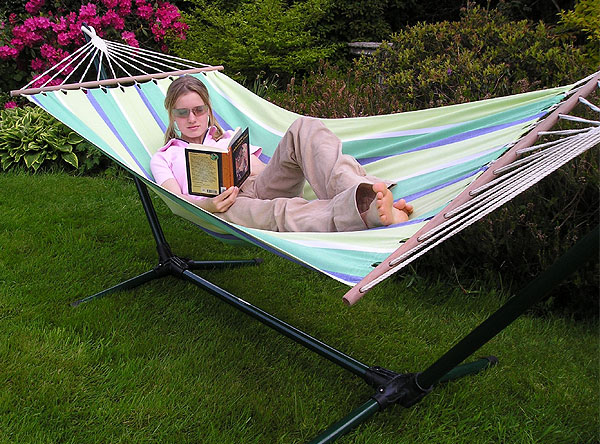
 ELIZABETH FIEND LIVING EDITOR It’s pitch dark out. I’m so far away from anything. There are absolutely no lights, except for the sparkles of a billion tiny pinpoints of light that I create each time I move. I’m floating in phosphorescent, bathwater-warm water, alone, off shore of a tiny island in the Caribbean Ocean far, far from the mainland somewhere between the border of Columbia and Panama. The island is postage-stamp size. It’s owned by a semi-autonomous tribe of Central American Indians called the Kuna. There are only a dozen people on the island. When I float to shore there are 13. I slip silently out of the water and move a few steps to a hammock strung between two bending palm trees and climb in. I fall asleep listening to the darkness and the sound of the waves hitting the island.
ELIZABETH FIEND LIVING EDITOR It’s pitch dark out. I’m so far away from anything. There are absolutely no lights, except for the sparkles of a billion tiny pinpoints of light that I create each time I move. I’m floating in phosphorescent, bathwater-warm water, alone, off shore of a tiny island in the Caribbean Ocean far, far from the mainland somewhere between the border of Columbia and Panama. The island is postage-stamp size. It’s owned by a semi-autonomous tribe of Central American Indians called the Kuna. There are only a dozen people on the island. When I float to shore there are 13. I slip silently out of the water and move a few steps to a hammock strung between two bending palm trees and climb in. I fall asleep listening to the darkness and the sound of the waves hitting the island.
It’s an unforgettable slice of heaven for sure, and one I can happily recreate in my own backyard. OK, not the sparkling green and blue water. Not the palm trees. Not the picture-perfect island. Alright, alright already, I have a hammock — but it’s my own soft, cotton cocoon. And it’s one of the best investments I ever made.
In fact, I have two hammocks: a net-like Mayan style hammock (like the kind us Gringos are familiar with), and one a bit more unusual. It’s from Ecuador and it’s made out of wool tightly woven into bands of brilliant reds, purples and blues. We always associate hammocks with the beach, but this Ecuadorian hammock, made for people who live way up in the Andes, keeps you toasty warm and has increased my outside hammock time by at least two months. I can settle in to a hammock in the late fall and the late winter months wearing a coat, sometimes with a small blanket, and watch the last birds of the season going about their business and later see the first early bird arrive. A crisp day is just as wonderful a time to relax as the hot summer one.
more unusual. It’s from Ecuador and it’s made out of wool tightly woven into bands of brilliant reds, purples and blues. We always associate hammocks with the beach, but this Ecuadorian hammock, made for people who live way up in the Andes, keeps you toasty warm and has increased my outside hammock time by at least two months. I can settle in to a hammock in the late fall and the late winter months wearing a coat, sometimes with a small blanket, and watch the last birds of the season going about their business and later see the first early bird arrive. A crisp day is just as wonderful a time to relax as the hot summer one.
Setting aside time to relax is really important to your health — mental and physical. I’ve found that by getting into a hammock on a regular basis you can really slip into “the zone” as easily and as quickly as with meditation.
Stress, anger and depression can harm our bodies and our personal relationships. An agitated mind throws our nervous systems out of whack. This can make us more susceptible to imbalances of the immune system, opening our bodies up to all kinds of illnesses from stomach ulcers to the common cold. Stress can also contribute to high blood pressure and heart disease, asthma — even diabetes. Emptying your mind by simply observing nature from a reclining position, with trees and clouds overhead — and enjoying the mesmerizing, slight swing of a hammock is a good way to relieve stress — to truly relax. It’s easy on the body too, resting overworked or tense muscles.
Just like meditation, taking a few minutes here and there to escape to a hammock and enjoy its gentle movement, and really getting into the Zen of the moment is a great way to bring about a relaxed state of mind. Using meditation to promote peace, calmness and happiness within yourself, you can actually rewire your brain to set these feelings as your default. And I believe frequent use of a hammock to relax can do the same thing.
There are basically two types of hammocks. One with spreader bars, and wooden dowels at each end, and the kind that’s just woven rope. They come in a few sizes. I’ve to come to believe the bigger the better. Each time my hammock has given out due to the effects of age and been ravaged by the elements I have upgraded to a bigger size.
About 1,000 years ago the first hammocks were made from the bark of the Hamak tree. Yeah, the name. Today, hammocks are usually made from cotton, wool or nylon. I prefer natural fibers over synthetic because they’re so soft on your skin. But the nylon ones last a lot longer.
 Two trees, preferably palm, perfectly distanced apart is the dream way to hang a hammock. One tree in your back yard with a hammock post is good too. A hammock post is a two part thingy. A hollow tube is sunk several feet into the ground, flush at ground level. You put a metal post, with a hook at the top for hanging the hammock, into the tube. The post can be removed to either mow around or to store inside when not in use. You can also use the hammock post and at the other end a strong hook sunk securely into a wall and hang your hammock from these with a couple of s-hooks and some rope. Use some sense here. Nothing can marsh-your-mellow more than the feeling that your hammock might fall down at any moment.
Two trees, preferably palm, perfectly distanced apart is the dream way to hang a hammock. One tree in your back yard with a hammock post is good too. A hammock post is a two part thingy. A hollow tube is sunk several feet into the ground, flush at ground level. You put a metal post, with a hook at the top for hanging the hammock, into the tube. The post can be removed to either mow around or to store inside when not in use. You can also use the hammock post and at the other end a strong hook sunk securely into a wall and hang your hammock from these with a couple of s-hooks and some rope. Use some sense here. Nothing can marsh-your-mellow more than the feeling that your hammock might fall down at any moment.
Other options include hammock stands, which is what I have. They come in a bunch of styles. Super reliable and a tad pricey, but a good one will last a lifetime. I have a green colored metal stand around which I have a lush planting of horseradish with its prehistoric, giant leaves; purple Joe Pie weed nodding in the breeze; and a smattering of tropical lilies; all — including myself– shaded by the graceful bamboo-like canes of elderberry on one side and the hand-shaped leaves of a fig tree on the other.
An outdoor pillow is really nice accessory. It dries quickly and doesn’t get moldy. After you’ve gone this far, just get the pillow, ok? Your ability to relax in a hammock increases with your comfort level.
There are lightweight hammocks which are small enough to take camping, hiking or to the beach. Or buy one of these and use it as a starter hammock if you’re broke.
There are even these crazy mosquito nets that you put your entire hammock into, then hang the hammock. They have a two-way zipper you use to open up the net and climb aboard. And YES, I have one! Nothing, will keep me away from my hammock not even hoards of West Nile virus-carrying insects.
How to get into a hammock (and out again, if you really must).
Put your back to the hammock. If no spreader bars, pull the front part forward and position your butt. Sit down. Pull the back part out, way up over your head if you can. Lie down. Put your feet up. Nirvana!
To get out of the hammock, swing your feet over the side and sit up and then push off with your arms to get up.
“They” say the best way to lie in a hammock is at an angle, though this doesn’t work for me. I like to lie straight down the center. I also love to sway. It’s so overwhelming relaxing. The fig tree to my right is perfect to push off of when the hammock stops moving.
Safety
Yes, I did fall out of my hammock once. Yes, I was drinking. Yes I was showing off. I was demonstrating to someone (OK, it was a bunch of people) how easy it was to get into the hammock with the mosquito net on. I opened the zipper and dove in, zooming right past the hammock onto the ground on the other side. It was really quite embarrassing. And quite difficult to get out of the mosquito net-sack once you had bypassed the hammock and were lying on the ground.
For More Information:
Places to purchase a hammock:
Mexihammock hammocks are a good deal and they contribute to the local economy of the indigenous women who actually weave the hammocks.
Buy American and support a “hippie” commune founded in 1967 and still going strong. Twin Oaks members support themselves with the business of book indexing, tofu making and hammock weaving.
Store: http://www.twinoakstore.com/
About Twin Oaks: http://www.twinoaks.org/
History of the hammock:
http://www.ecomall.com/greenshopping/hammock.htm
http://store.buyhammocks.com/hiofha.html
ABOUT THIS COLUMN: At no time in recorded history have we possessed so much knowledge about health and nutrition, nor have we ever had such vast and effective machinery for disseminating that knowledge — and yet, for all intents and purposes, we live in hi-tech Dark Age with the vast majority of the global population essentially ignorant or confused about the basic facts of their own biology. How did this happen? Well, that’s a whole six-part mini-series in and of itself, but the short answer is that the bottom line of many a multi-national corporation is dependent on that ignorance, and vast sums of money are expended to maintain it. The global warming argument is a classic example. When scientific fact did not favor Big Oil, they hired their own scientists to to conduct and publish studies that contradicted the peer-reviewed facts about the environmental impact of carbon-based emissions. As a result, whenever the latest global warming news is relayed to the public, it always comes with the caveat that “some dispute these findings.” There was time when newspapers saw it as their duty to truth squad these debates, but that’s long since become a luxury most papers can no longer afford — better to hire another gossip columnist and give the people what they want. To fill this crucial gap, Phawker began publishing the JUNK SCIENCE column by Elizabeth Fiend, beloved host of Big Tea Party. Every week, Miss Fiend connects the dots to reveal a constellation of scientific facts that have been hiding in plain sight — scattered across the vast, cold reaches of the Internet. With a background in punk rock and underground comics, and longstanding employment as a library researcher, Miss Fiend doesn’t pretend to be a scientist or an expert. She does, however, know how scientific facts become diluted by corporate-sponsored non-facts, and every week she separates the smoke from the mirrors. Why? Because she loves you.
